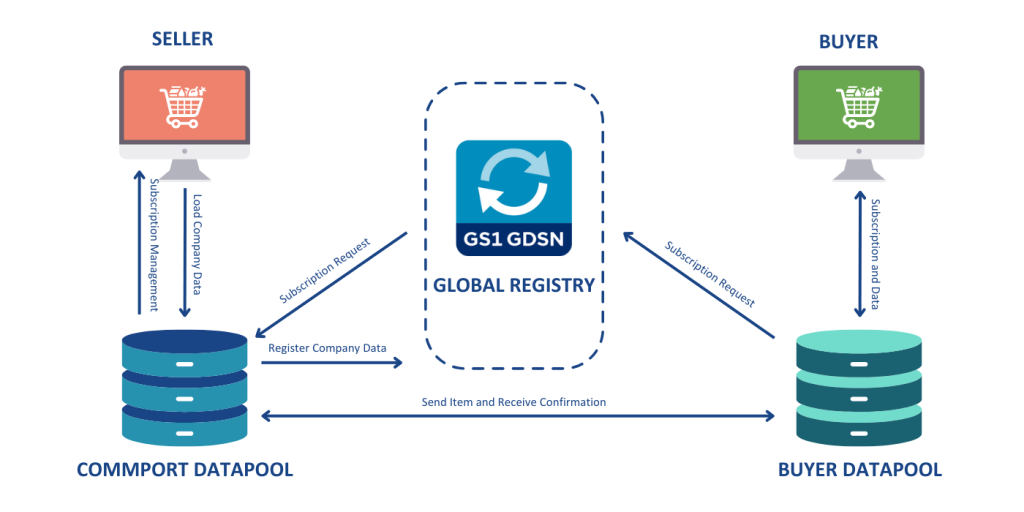Introduction
Today’s shoppers demand consistent and reliable information about the products they choose whether they are shopping online or in-store. To provide such high-quality product data to consumers, brands rely on advanced product data management solutions like GDSN to synchronize their product data to various sales channels like eCommerce stores, mobile apps, and other marketplaces.
The Global Data Synchronization Network (GDSN) plays a pivotal role in facilitating seamless communication between brands, retailers, and trading partners, ensuring that product data is consistent and reliable across various platforms.
What is eCommerce?
eCommerce (electronic commerce) refers to the buying and selling of goods and services online. It has transformed traditional retail by enabling businesses to reach global audiences, streamline operations, and offer a convenient shopping experience to consumers. Today consumers are looking for seamless online and offline experiences and to help this demand brands are focusing more on an omnichannel retail strategy.

Key Aspects of eCommerce
- B2C (Business-to-Consumer): Online stores selling products directly to consumers (e.g., Amazon, and Shopify stores).
- B2B (Business-to-Business): Wholesale transactions between businesses (e.g., manufacturers selling to retailers).
- C2C (Consumer-to-Consumer): Peer-to-peer transactions on platforms like eBay.
- D2C (Direct-to-Consumer): Brands selling directly to customers, bypassing third-party retailers.
- Omni-Channel Commerce: Integration of multiple sales channels, including marketplaces, social media, and physical stores.
With millions of product listings across various online marketplaces, maintaining consistent and up-to-date product information is a challenge. This is where GDSN steps in
Understanding GDSN
The Global Data Synchronization Network (GDSN) is a worldwide network of interoperable datapools that enable businesses to exchange standardized product data in real-time. It ensures that all trading partners—whether manufacturers, retailers, or distributors—have access to accurate, synchronized product information.

Key Components of GDSN
1. GDSN DataPools
Datapools are the backbone of the GDSN, serving as centralized repositories where product information is stored and shared. Brands can publish their product data to these pools, allowing trading partners to access the information they need. Utilizing a GDSN datapool simplifies the process of maintaining accurate product information and reduces the risk of errors.
2. GDSN Attributes
GDSN attributes refer to the specific data points that define a product, such as its name, description, dimensions, price, detailed packaging hierarchies, nutritional facts, product weights, dimensions, and high-quality imagery. Such comprehensive data is the cornerstone for any retailer seeking to uphold the accuracy and dependability of their supply chain. These attributes must adhere to GS1 standards to ensure consistency across different platforms. By standardizing attributes, GDSN enables retailers to present product information in a way that is easily understandable to consumers.
3. GS1 Standards
GDSN operates on GS1 standards, which ensure that product data follows globally accepted identifiers such as GTINs (Global Trade Item Numbers), GLNs (Global Location Numbers), and GPCs (Global Product Classification Codes).
4. Product Data Syndication
Product data syndication is the process of distributing product information across various online marketplaces and retail platforms. GDSN streamlines this process, allowing brands to publish their product data once and have it automatically synchronized across multiple channels. This efficiency not only saves time but also enhances the visibility of products in the marketplace.
5. Trading Partners
GDSN facilitates seamless communication between manufacturers, suppliers, retailers, and marketplaces, ensuring that every stakeholder receives accurate product information.
6. Data Governance & Compliance
GDSN ensures that all product data complies with industry regulations, labeling requirements, and government standards.
The Importance of GDSN in eCommerce

The Global Data Synchronization Network (GDSN) plays a vital role in eCommerce and digital shelf management by ensuring product data consistency across multiple online and offline sales channels. Its integration with eCommerce platforms enables businesses to maintain accurate, up-to-date product information, allowing for a seamless shopping experience whether customers browse online or shop in-store.
By leveraging GDSN, retailers and manufacturers can synchronize essential details—such as product specifications, pricing, and availability—across all marketplaces in real-time. This eliminates discrepancies, enhances product visibility, and builds consumer trust by providing reliable, standardized product data regardless of the purchasing platform.
GDSN helps in:
1. Enhancing Product Data Accuracy Across Online Marketplaces
Accurate product data is the foundation of successful eCommerce operations. With GDSN, businesses can ensure that product descriptions, pricing, images, and specifications are consistent across multiple platforms. This reduces confusion, improves search visibility, and enhances customer confidence in purchasing decisions.
2. Improving Supply Chain Efficiency by Reducing Order Discrepancies
Order discrepancies arise when incorrect product information leads to errors in fulfillment, resulting in delayed shipments, returns, and increased operational costs. By using GDSN, businesses can synchronize real-time product details with their trading partners, minimizing the risk of miscommunication and streamlining order processing.
3. Meeting Regulatory Requirements for Product Labeling and Ingredient Disclosures
Compliance with product labeling regulations is crucial, especially in industries such as food, pharmaceuticals, and consumer goods. GDSN ensures that businesses adhere to global GS1 standards, providing accurate ingredient lists, allergen information, nutritional values, and safety warnings. This is essential for meeting legal requirements and avoiding regulatory penalties.
4. Reducing Costs Associated with Manual Data Entry and Incorrect Product Details
Manual data entry is time-consuming and prone to errors, leading to costly mistakes in product listings and order fulfillment. GDSN automates the process of updating and maintaining product data, eliminating redundant tasks and reducing operational expenses.
5. Boosting Consumer Trust by Providing Transparent, High-Quality Product Information
Shoppers today demand transparency in product details, from sustainability practices to origin tracking. GDSN helps businesses provide reliable, high-quality product information that builds consumer trust, reduces return rates, and enhances brand reputation.
With the increasing demand for omnichannel commerce, GDSN enables businesses to deliver consistent product experiences across multiple sales platforms.
Future Outlook for GDSN in eCommerce
- Rise of 2D Barcodes for Enhanced Product Data
The traditional 1D barcodes (UPC/EAN) are being replaced by 2D barcodes (such as QR codes and Data Matrix codes) to store and share richer product information. These next-gen barcodes can hold detailed data like expiration dates, batch numbers, and links to digital product pages. With GDSN integration, businesses can ensure that 2D barcode data remains accurate, synchronized, and accessible across eCommerce platforms.
- Digital Product Passports (DPP) for Transparency and Sustainability
Governments and regulatory bodies are pushing for Digital Product Passports (DPPs) to provide end-to-end product traceability. These passports store key details like supply chain origins, sustainability certifications, and recyclability information. By integrating DPPs into GDSN, businesses can automate compliance, enhance brand transparency, and build consumer trust in eco-conscious markets.
- Internet of Things (IoT) for Real-Time Product Monitoring
The rise of smart devices and IoT sensors enables real-time tracking of inventory, shipments, and product conditions (e.g., temperature-sensitive goods like pharmaceuticals). GDSN can be leveraged to sync IoT-generated data with eCommerce platforms, helping businesses reduce waste, optimize logistics, and prevent counterfeit products.
- AI and Machine Learning for Smarter Data Management
Artificial Intelligence (AI) and Machine Learning (ML) are transforming product data management and GDSN processes by:
- Automating product categorization and content enrichment
- Enhancing error detection in product listings
- Predicting inventory trends and demand forecasting
By incorporating AI-driven analytics into GDSN, businesses can optimize product visibility, pricing strategies, and operational efficiency.
Cocnlusion
By facilitating accurate and timely product data sharing, GDSN enhances data accuracy, supports omnichannel retailing, and ensures regulatory compliance. While challenges exist in implementing GDSN, the benefits far outweigh the obstacles. As businesses continue to adapt to changing consumer expectations and technological advancements, GDSN will remain a cornerstone of successful eCommerce strategies.
Commport GDSN Datapool Solution
Download: GDSN Buyers Guide
Empower your business with global data synchronization; download our GDSN Buyer's Guide today and take the first step towards streamlined, accurate, and compliant product data management.
Frequently Asked Questions
Online retailers benefit from GDSN through improved product data accuracy, reduced manual data entry, faster onboarding of new products, better customer experiences, and easier compliance with global and industry-specific standards.
Yes, many large marketplaces such as Amazon, Walmart, and Target require suppliers to comply with GS1 standards, which are the foundation of GDSN. Using a GDSN-certified data pool helps businesses meet these platform requirements.
GDSN supports a wide range of product data, including product names, descriptions, images, ingredients, nutritional information, packaging dimensions, compliance labels, GTINs, and pricing details.
Product data updates in GDSN occur in real-time. Once the data is modified in the data pool by the brand owner or supplier, it is instantly synchronized with all connected trading partners and systems.
GDSN ensures that product data is accurate and up to date, helping businesses comply with regulatory requirements related to labeling, allergens, safety, sustainability, and digital traceability such as Digital Product Passports.
When choosing a GDSN provider, consider factors like GS1 certification, industry experience, customer support, integration capabilities with your existing systems, scalability, and overall cost. Providers like Commport Communications offer robust and reliable GDSN solutions for global eCommerce needs.





